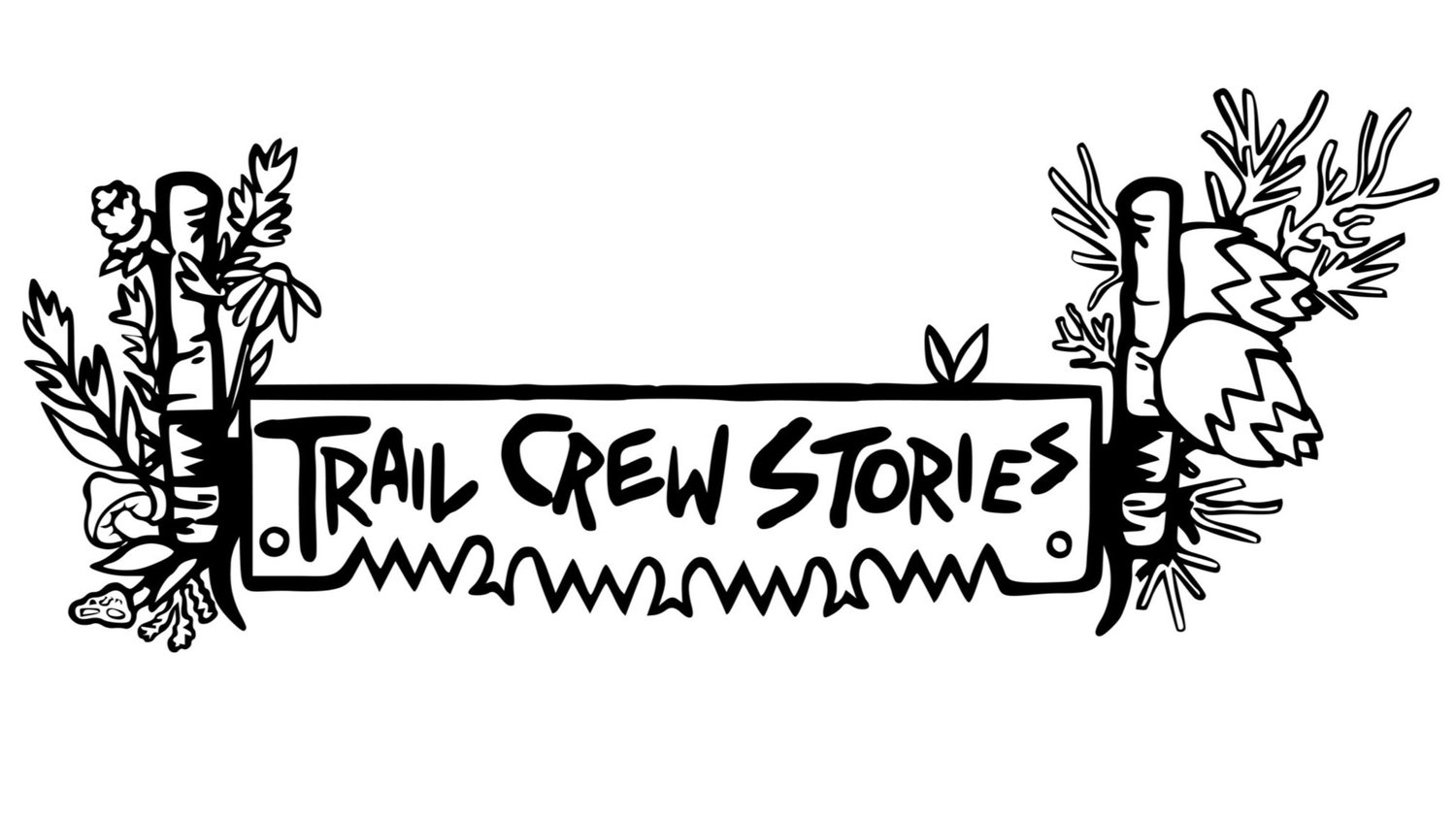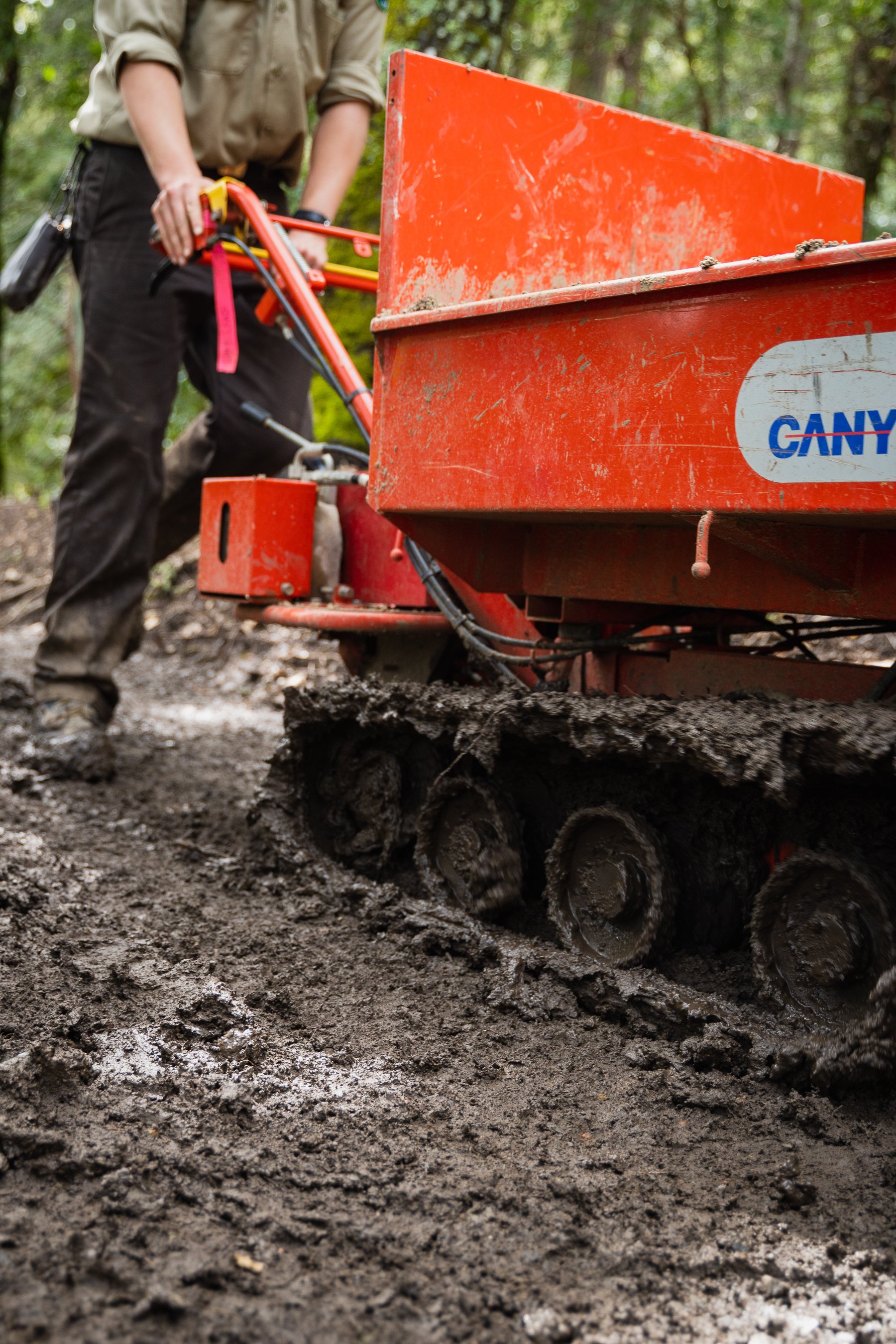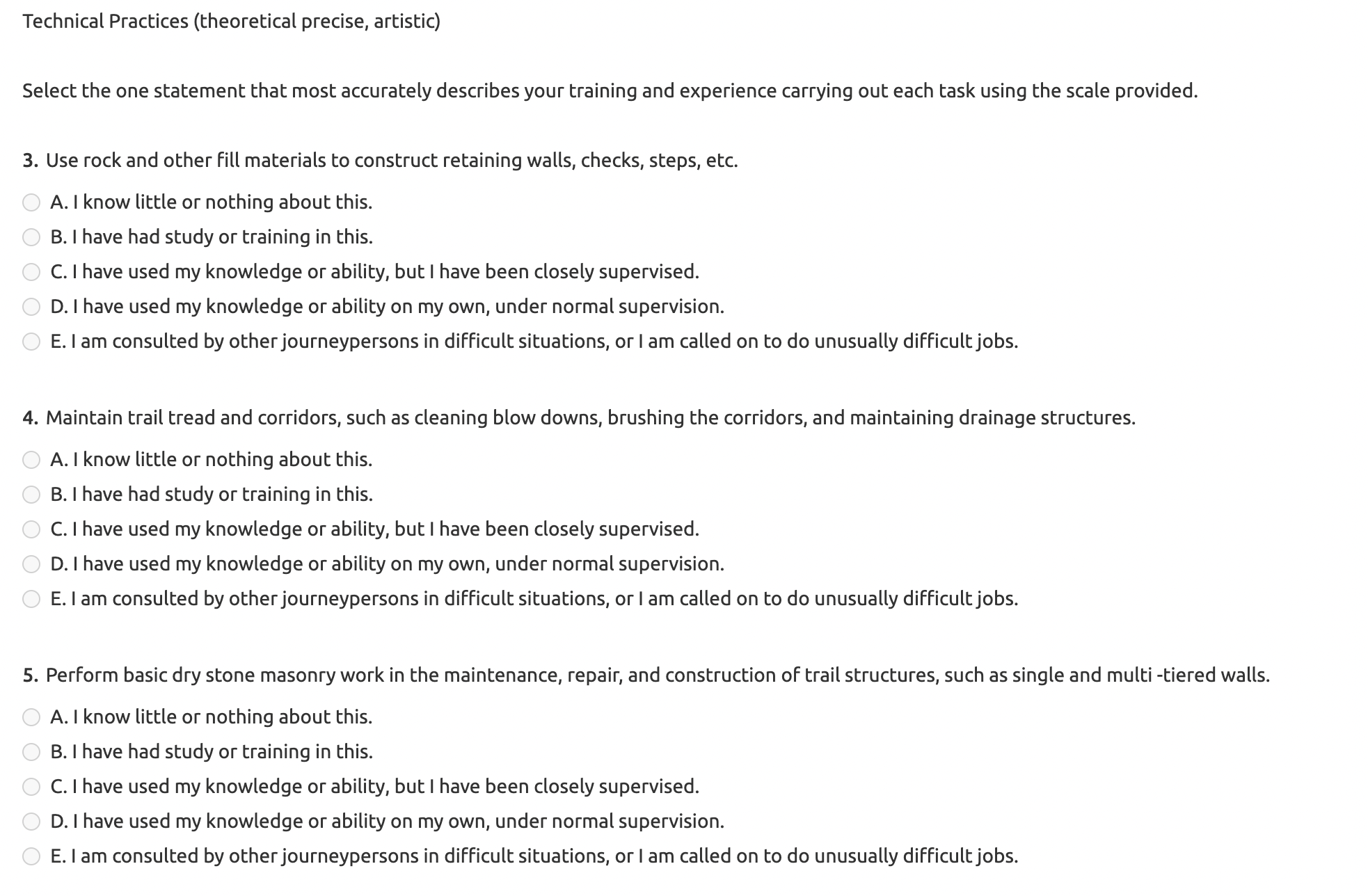How to Get a Job in Trails
**AUGUST 2025 UPDATE: I originally wrote this guide in August 2024, five months before the Trump Administration began its ongoing campaign to reduce the federal workforce and slash funding to federal grants and conservation projects. In February 2025, thousands of probationary employees in the US Forest Service and National Park Service were fired from their roles, many of whom were trail workers or in roles that support trail crews. Many of these folks were re-offered their jobs, but the lasting impact is a lingering uncertainty around federal positions that were once considered reliable sources of employment in land management. At the time of this update, there is still a hiring freeze for permanent positions. Trail organizations in the private sector, including the for-profit sector, are feeling the ripple effects as grant money becomes frozen and contract negotiations are stalled by short-staffing at the federal level.
Nonetheless, trailwork is still happening, and the federal agencies are still hiring seasonal positions. It’s likely that all the uncertainty will increase competition for available trails jobs, as experienced workers displaced from other agencies seek stability. You’ll need to bring your A-game to your application process, as well as into the field. Our short-staffed public lands need top talent now more than ever.
The federal hiring process has changed in one significant way: your federal resume can be no longer than two pages, a big change from the days when federal resumes might be ten pages or longer. See the federal hiring subchapter for details. **
One of the most frequent questions I get asked is, “how did you get into trail work?” Growing up in the suburbs of Washington, DC, working in Trails (or land management more broadly, for that matter) was never a career path that was on my radar. Like many trail workers, I had stumbled into the profession through a hodgepodge of connections and experiences in mountain biking, volunteering, and AmeriCorps.
In my experience, the people who directly enter Trails out of high school or college are rare. It is much more common to meet folks who had worked in other fields or had other career goals, who, like me, stumbled into Trails inadvertently and fell in love with it.
There is no direct trajectory into this field. Aside from Northwest Community College in Arkansas, there are no higher education institutions teaching these skills. Most trail workers have learned in the field by doing.
Trail work isn’t rocket science, and I believe anyone can do it. Perhaps more important than technical skill or brute strength is grit. Trail work is tough and often uncomfortable. The pay is low and work is typically seasonal. But if you’re willing to sacrifice some financial and geographic stability, trail work can offer the adventure of a lifetime.
So, you want to take the plunge? Here are some tips:
Volunteer with a Trail Crew
The best way to get a taste of the job is to spend a day or two volunteering with a local trail crew. Try to find a professional crew—perhaps at your local state park, National Park, National Forest, or non-profit organization—rather than an all-volunteer crew. While there are plenty of good volunteer groups out there, if you want to become a professional trail worker, you’ll get the best perspective by working alongside professional trail workers.
Instead of waiting for a public sign-up sheet, just reach out to ask if you can come out to volunteer. Tell them you’re interested in trail work professionally. You’ll likely be able to join a crew and have a much more intimate experience than you would in a large volunteer group.
Start Searching Early
Begin your job search early. Many summer trails jobs get posted as early as November. Sign up for job alerts on job boards such as Conservation Job Board, Cool Works, American Trails, and USAjobs. Winter job listings often go up in late summer, around August-September.
Gain Experience with Entry Level Positions
Your first trails gig is probably not going to be on a National Park Trail Crew, or riding in helicopters to the Alaskan Wilderness. You’ll likely need to gain some entry-level experience before having sufficient skills for more badass trails jobs.
The most common way to gain entry-level experience in trails is through a Conservation Corps. These are usually team-based, residential programs that are modeled after the Civilian Conservation Corps of the 1930s. There are 150 Corps programs around the USA, and you can browse these programs on the Corps Network site. Most conservation corps programs are not paid—rather, participants have their food and living arrangements provided, receive a living stipend, and also receive a scholarship award upon completion of service.
Not all conservation corps specialize in trail work. Many focus on other objectives, such as habitat restoration, urban landscaping, historic preservation, or energy efficiency. Look at the portfolio of projects that a Corps has accomplished to get a sense of what your experience would be like.
Aside from Corps programs, many non-profit organizations hire entry-level trail workers. This may be a necessary step for folks who are above the maximum age range of youth conservation corps. These types of entry-level jobs may also be listed as internships. Land Trusts are another type of non-profit organization that may be hiring for trails jobs. Keep an eye on the job boards linked below for entry-level positions.
Yet another option is to volunteer often and consistently. Not only will you build your network, you’ll also be able to pick up many of the basic skills and techniques to step into a professional role.
State, Regional, and Local Parks
State, regional, and municipal park districts may have trail crew opportunities as well. This is often location-dependent—cities with more parklands in the vicinity will typically have more of these openings. These positions are usually filled through state or city-level staffing portals and websites.
Compensation, experience required, and duties can vary greatly from city to city and state to state. In some states and counties, trail work may be performed by more generalist Park Rangers who may also have law enforcement duties. Municipal Parks and Recreation jobs may involve some trail work alongside other more general maintenance duties. Do your research and reach out to local agencies to better learn about their job duties.
As always, doing a shadow day or showing up as a volunteer is advisable. You might wind up disappointed if you accept a job thinking you’ll mostly be doing trail work when in actuality most of it is cleaning toilets or powerwashing graffiti (although these jobs, too, can be a great way to get your foot in the door with a parks agency).
Federal Hiring: Great Jobs, Awful Application Process.
Want to work for the National Park Service, Forest Service, Bureau of Land Management, or Fish and Wildlife Service? You’ll need to learn to navigate the bureaucratic cyber-labyrinth: USAjobs.gov.
The great irony of USAjobs is that In creating a system intended to be as unbiased and fair as possible, they have created a system that is so complex and convoluted, you typically need insider help to understand how to navigate it. Here are my top tips derived from years of seeking (and finding) jobs on this site.
Learn the right keywords. Many job titles do not intuitively describe the job itself. The National Park Service lists many trails jobs as “Laborer”, “Maintenance Worker” or “Motor Vehicle Operator.” They may or may not include “Trails” in the title (i.e, “Maintenance Worker (Trails).” Don’t ignore job listings that don’t include “Trails” or “ Trail Worker” in the title. Take a moment to read the description and see if it includes trail work.
Use keywords to create saved searches. To create a saved search, just enter search terms and click the “Save this search” button. Even if you’re search doesn’t turn up any results, you can save it and have it alert you when a job listing gets posted that matches your search terms.
Locations listed are often the nearest city to the National Park not the park itself. USAJobs has gotten better about this recently to include both the name of the park and the location. If there is a specific park you’re interested in, be sure to also learn the name of the municipality so you can capture that as a keyword in saved searches. For example, if you want to work in Rocky Mountain National Park, you should also search “Estes Park” in your keywords.
Preview the Questionnaire for the job(s) you’re interested in. They make this way too hard to find. Scroll all the way down to the “How to Apply” section and click the link where it says you can preview. You will need to fill this out as part of the application process, so it’s good to see the questions in advance. It is also helpful to use the questionnaire to make sure you have all the skills covered in your resume.
Make your Federal Resume, using the questionnaire as a template. **2025 UPDATE: federal resumes must be two pages or less. The hiring managers will not read past the first two pages if it is longer. This is a shift from the old paradigm of a federal resume being extremely long, perhaps ten pages or more. In the old version of this guide, I suggested using the Resume Builder on USAJobs. Now, I would suggest using Microsoft Word or another word processor to have maximum control of formatting. Use small fonts and small margins (although don’t make it outrageously small) to fit more information. A human WILL read your resume so don’t go overboard with small fonts—it must be legible. At the same time, you want to include as many keywords as possible to match the questionnaire. Look at the Questionnaire for a specific job in advance so you can tweak your resume accordingly to closely (but also truthfully) match your resume. Be honest on your resume. AI tools such as ChatGPT are helpful for condensing a big resume into two pages.**
Apply by submitting your resume and questionnaire. Once you’ve created your resume, it’s very quick and easy to apply. You may also need to upload additional documents if you were previously a federal employee. When you fill out the Questionnaire, recognize that you will probably need to put “E” level for everything if you want a chance at getting hired. I’m not telling you to lie about your credentials or skills. But what I am saying is that if you don’t put “E” Level for everything, your application will probably be discarded before a human ever sees it. Don’t let the system filter you out–let a human hiring manager decide if you are qualified by reviewing your resume. Be truthful in your resume, and they can decide if you are qualified. Take this advice as you wish…
Prepare for a referral. Initial review of applications happens at the regional level. If the regional HR folks deem you qualified, your application will get “referred” to the hiring manager at the specific park or forest. You will receive an email if this happens. This means that you’ve made the shortlist, and your application has now been sent to the local trails supervisor who will decide who on this list to interview and ultimately offer the job. At this point, it is a good idea to proactively contact the supervisor doing the hiring (you may need to call and email several people before you find the right one) and express interest up front. It’s also a good opportunity to ask questions about the job duties, available housing, etc.
Interview. If you’re a top candidate, the hiring manager will likely reach out for an interview. Each trail program does interviewing differently, but in general they tend to be pretty casual. Be prepared to share your experience, and your excitement for the opportunity. This is also a great time to ask questions about the program, the projects, and the schedule, so have those on deck.
The World of Private Trails Contracting
Many experienced trail builders choose to enter for-profit private trails contracting. These are often small companies of experienced builders and heavy equipment operators. This is a rapidly growing industry driven in recent years by the surging popularity of mountain biking, and many projects are mountain-bike specific. Private contractors may also be contracted by public agencies to tackle highly technical projects such as ADA trails, bridge builds, boardwalks, trailhead design, and scenic overlooks. Companies may even be contracted to build trails on private property for wealthy or corporate clients.
Private trails contractors are among the highest-paid in the industry. They also travel often (sometimes all around North America) and work long hours to stay on tight deadlines.
Most of these contractors are members of the Professional Trail Builders Association, which has an annual conference and also its own job board in partnership with American Trails.
Frequently Asked Questions
Q: Do you need a college degree to do trail work?
A: No. A college degree is not required for a job in Trails. For those interested in designing trails at a high level, a degree in engineering or landscape architecture is probably most relevant.
Q: Does “full-time” mean “permanent”?
A: People often get these terms mixed up. “Full-time” means 40 hours a week (as opposed to “part-time”). “Seasonal” means the job is temporary, typically limited to a six-month season (1039 hours for Federal Jobs). Most Trails jobs are Full-Time and Seasonal. Many permanent trails jobs are “Career Seasonal” which means they have permanent benefits (Retirement funds, pension, etc.) but include a period of unpaid furlough, which could be anywhere between two weeks and four months.
Q: Once you’re in the Federal Service, can you get “sent” to other parks?
A: No. This is another common misconception. The government does not ship out employees to other places like soldiers in the military. If you want to move to another park, you have to apply to a job at that specific place when it gets posted and compete for it.
Q: What certifications are required or useful for a Trails job?
A: For many jobs, the only requirement is having a valid Driver’s License. Otherwise, the most common certifications are S-212 Wildland Fire Chainsaws, Wilderness First Aid, Wilderness First Responder, and the Red Card (Wildland Fire). Many organizations and agencies will pay for your training, so don’t stress too much if you don’t have these. But it’s a plus if you already do.
Q: What is a “non-competitive hiring authority?”
A: Some programs, such as the US Military, Peace Corps and AmeriCorps, offer a perk of “non-competitive” status upon completion of service. This does not mean that you are guaranteed a job. A better way to think of it is your application going to the top of the stack, if you’re qualified. You might be competing against other “non-compete” candidates. Rules differ between programs, and this benefit is powerful for military veterans but pretty diluted for Peace Corps and AmeriCorps alumni. Put shortly, it is a benefit, but likely not as helpful as the Peace Corps and AmeriCorps recruiters might make it out to be.
Q: What other jobs do trail workers do?
A: Trail workers are sometimes called in to assist with other agency missions. This might include Search and Rescue operations, biological monitoring, habitat restoration, or even mundane heavy-lifting tasks like moving heavy furniture.
Q: Can I find a job in Trails in the USA if I’m not a US Citizen?
A: Many youth Conservation Corps only require permanent residency (ie, Green Card) status. For non-residents, they would need to be sponsored on a temporary work visa such as J-1. This is rare but not impossible. Otherwise, volunteering while on a tourist visa visit to the USA is always an option.
Job Boards
Learning Resources
Santa Cruz Trails Trail Academy (online and in-person in Santa Cruz, CA)
Pacific Crest Trail Skills Colleges (various locations in CA, OR, WA).
RMFI Pikes Peak Regional Crew Leader Training (in-person in Colorado Springs, CO)
Trailism (online resources and science of mostly mountain bike trailbuilding)
Good luck! Feel free to reach out if you have any specific questions.









